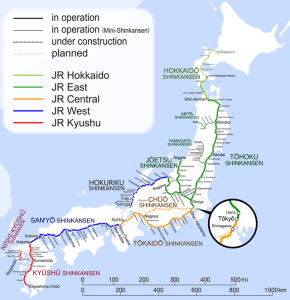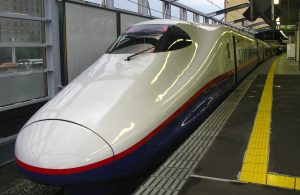Technology
139 Japan’s Shinkansen Railway
Ashley Crouse
Introduction
The Shinkansen, often called the “bullet train,” is Japan’s high-speed rail (HSR) system and has had many benefits for Japan since it was built in 1964. It currently connects many of the major cities in Japan. The Shinkansen was also the world’s first high-speed train, leading to the use of HSR in other countries, such as France, Germany, and Spain. The first line of the Shinkansen network was built to connect Tokyo with Osaka. Newer lines connect Kobe, Kyoto, Hiroshima, and Nagano. The primary purpose of the Shinkansen is to connect Japan’s larger cities and shorten the time it takes to travel between them. For example, in 1889, it took over 16 hours to travel between Tokyo and Osaka by train. When the Shinkansen opened, it cut the time down to three hours and ten minutes (Jones, 2024). Overall, the Shinkansen had many benefits for Japan, such as shorter travel time, increased tourism, and improved safety.
Connection to STS
With being the first high-speed rail line, the Shinkansen is a perfect example of technological advancement and changing society. The creation of the Shinkansen paved the way for more HSR lines in other countries as well as even further advancements to train travel in general. The safety features of the trains are also a huge technological advancement. Additionally, the Shinkansen has helped society by making the longer commutes more feasible and accessible. The faster trains have not only improved overall traffic efficiency but have also encouraged economic growth and suburban development since people can travel to more urban areas quicker.
History of the Shinkansen

Japan’s economy and infrastructure were in shambles following the Second World War. Officials thought that one way to help improve the economy was to invest in Japan’s transportation system. However, rail travel was reaching its capacity. At the time, many people thought the improvements in road and air travel would become more popular than trains. Japanese National Railways (JNR), Japan’s national railway company, argued that a high-speed rail system spanning the country would not only help with transportation problems but also help the economy (Nickelsburg, 2018). Another problem was that the 1964 Olympic Games were set to be held in Tokyo, Japan. Many people were expected to travel to Tokyo and surrounding cities, and traffic congestion was expected to get worse. What is the solution to these problems? Japan created the world’s first bullet train: The Shinkansen.
In 1959, Japan invested 1.3 billion US dollars into the construction of the first Shinkansen line, running 515 kilometers between Tokyo and Osaka, two of Japan’s biggest cities, one of the most congested rail lines at the time. The creation of this line reduced the travel time between the cities by over 50% (Harnish, 2024). In what was originally almost a seven-hour train ride, it was now only three hours (Bohn, 2022). Because of its success, the line was expanded down to Fukuoka in 1975.
Today, the railway is over 2,600 km long and transports 340 million passengers annually. The Tokaido-Shinkansen railway was the first to reach the bullet train speed of 210 km/h or about 130 mph. Currently, there are nine Shinkansen lines connecting many of Japan’s cities and regions including the islands of Hokkaido, Honshu and Kyushu. In March 2024, the Hokuriku Shinkansen line opened, adding a connection to Tsuruga.
Computer-Aided Train Traffic Control (COMTRAC)
The Centralized Traffic Control (CTC) system originally controlled Shinkansen’s traffic. This was controlled by dispatchers who were required to make a multitude of decisions about train operation and to issue commands to drivers and stations on top of ordinary tasks like setting up train routes under normal conditions. However, as more and more lines were added this method of operation became extremely insufficient. Because of this, in 1967, it was necessary to switch to a computer system for train control and traffic management, which is how the Computer-Aided Train Traffic Control (COMTRAC) system was created.
It was crucial that this system could be reliable and responsive to control the high-speed train in real-time. However, due to the limitations of technology of the 60s, COMTRAC was not able to achieve full functionality until phase two, which was installed in 1975. Phase two of COMTRAC saw vast improvements, including increasing the number of computers used to help forecast and reschedule train patterns. This system is centrally controlled from Tokyo, with a secondary center in Osaka as a safety measure.
Socio-Economic Benefits of the Shinkansen
One of the biggest benefits of the Shinkansen and other HSR lines across the world is shorter travel times. The fastest HSR Line in Japan can reduce travel times by 76.15% when compared to standard rail lines (Rungskunroch, 2021). These shorter travel times have impacts on both locals and tourists. For locals, shorter travel times lead to reduced commutes or being able to commute further in a shorter amount of time, which allows them to live further away from work or school. The impact for tourists is that they are able to travel to more rural parts of Japan. Tourists are also able to spend more time at their destination, leading to them spending more money while traveling. Areas near each train station have become hubs for stores and restaurants. For example, the area around the station in Kyoto is “home to 130 shops and restaurants” (Harnish, 2024).
Another economic benefit of the Shinkansen is the creation of more jobs. Cities in Japan near Shinkansen stations have seen employment rates of around 16-34% higher than cities without HSR stations. The growth of the areas with the stations is around 0.5% higher than the areas without the stations (Rungskunroch, 2021). The differences in the increases in employment rates as well as growth rates when comparing cities or towns with HSR stations to those without showing the positive economic impacts of the Shinkansen.
People no longer needed to live in the city center. Because of the Shinkansen and other smaller rail lines, getting to the city for work or school was easier. This led to a shift in how the populations in Japan were distributed. Shizuoka, a city 175 kilometers west of Tokyo, saw an increase in development after the construction of the first line. The population spread out, and housing prices within larger cities decreased (Harnish, 2024). The population density around each Shinkansen station is much higher than it is in other parts of Japan.
Other Benefits
One of the main concerns that many people have with any new form of transportation is safety. This is especially true for the first high-speed rail system. Fortunately for the Shinkansen, there have not been any collisions or derailments on any of the Shinkansen lines that resulted in passenger fatality. The Shinkansen has had zero fatalities in the sixty years it has been operational. Another impressive feat the Shinkansen is able to accomplish is that the trains will run regardless of the weather. The trains are still able to reach their maximum speed in heavy rain. This is because of the trains’ Automatic Train Control System (ATC). The ATC will automatically stop or slow down the train when it approaches another train or its next stop. One of the biggest causes of collisions on trains is at intersections with roads. The Shinkansen avoids this by having a dedicated track that goes either above or below the road to avoid any possible collision with a car (Jun, 2024).
Train travel, in general, tends to be less stressful than other forms of public transportation. There is not often security to go through, and no need to arrive at the train station hours before the train is set to depart. While traveling by plane might be comparatively faster, the convenience of train travel, especially on HSR, makes choosing to travel by train the better option. The Shinkansen is one of the most reliable railways in the world. A lot of complaints about train travel is that there can be many delays. Japan does not have to worry about that with the Shinkansen since in 2023, there was only an average delay of 1.6 minutes per train for the Tokaido Shinkansen trains (JR Central: Average Delay of Shinkansen Trains 2021, 2024). These short delay times can be attributed to the railway’s ability to operate up to 15 trains during peak hours. In contrast, Germany’s rail network company, Deutsche Bahn, had only 64% of the trains arriving on time or within six minutes of the scheduled arrival time (Berry, 2024). Because of this, Japan’s public transportation system is one of the most efficient ways to get around the country.
Due to cities being connected in this new way, people could now form a larger geographical identity. It also helped people reimagine their own relationship with their cities. Additionally, this new connectedness helped to enhance Tokyo’s status as a hub for people, commodities and information as they passed through the city. Fascination with the railway has always been prominent, with many books and movies set near or on the trains. It was originally nicknamed “The Golden Route” by travelers. In 2022, an American film was released called “Bullet Train”, where majority of the film takes place on this famous railway. With this publicity, the trains have become their tourist destination for foreigners.

Conclusion
In conclusion, the Shinkansen has revolutionized rail travel by introducing high-speed rail, paving the way for faster and more efficient rail travel. It has not only led to a decrease in travel times but has also boosted economic growth and improved safety standards for train travel. The Shinkansen stands as an example of the intersection between science, technology, and society in that it shows how improvements in technology can lead to societal and economic changes. Overall, the Shinkansen has improved life in Japan for both locals and tourists, and it has set a standard for future high-speed rail lines around the world.
References
Akita, K., & Hasegwa, Y. (2016). History of COMTRAC: Development of the Innovative Traffic-Control System for Shinkansen. IEEE Annals of the History of Computing, 11-21. https://ieeexplore-ieee-org.libproxy.clemson.edu/stamp/stamp.jsp?tp=&arnumber=7155450&tag=1.
Berry, A. (2024, January 12). Germany: A third of long-distance trains delayed in 2023. Dw.com; Deutsche Welle. https://www.dw.com/en/germany-a-third-of-long-distance-trains-delayed-in-2023/a-67964403.
Bohn, K. (2022, February 17). Exploring how the world’s first bullet train captivated the globe | Penn State University. Www.psu.edu. https://www.psu.edu/news/research/story/exploring-how-worlds-first-bullet-train-captivated-globe.
Carter, P. (2024, Nov 28). How the Bullet Train Transformed Japan. BBC. https://www.bbc.com/travel/article/20241126-how-the-bullet-train-transformed-japan.
Deutsche Bahn train punctuality Germany 2019-2021. (2024, November 12). Statista. https://www.statista.com/statistics/935040/deutsche-bahn-train-punctuality-germany/.
Harnish, R. (2024, July 7). The Shinkansen: How high-speed rail transformed a nation . High Speed Rail Alliance. https://www.hsrail.org/blog/the-shinkansen-how-high-speed-rail-transformed-a-nation/.
Igarashi, Y. (2023). Dream Super-Express: A Cultural History of the World’s First Bullet Train. The Journal of Japanese Studies, 49(1), 197-200. https://doi.org/10.1353/jjs.2023.0019.
Jones, Ben. (2024). How Japan’s Shinkansen bullet trains changed the world of Rail Travel. CNN. https://www.cnn.com/travel/japan-shinkansen-bullet-trains-60-years/index.html.
JR Central: average delay of Shinkansen trains 2021. (2024, November 15). Statista. https://www.statista.com/statistics/1267031/jr-central-high-speed-train-tokaido-average-delay/.
Jun, U. (2024, October 24). Safety and Convenience: How the Shinkansen Changed Japan. Nippon.com. https://www.nippon.com/en/in-depth/d01045/.
Nickelsburg, J., Ahluwalia, S., & Yang, Y. (2018). High-Speed Rail Economics, Urbanization and Housing Affordability Revisited: Evidence from the Shinkansen System. Anderson School of Management University of California, Los Angeles, 24.
Rungskunroch, P., Jack, A., & Kaewunruen, S. (2021). Socioeconomic benefits of the shinkansen network. Infrastructure, 6(5), 68.
Images
“Shinkansen Map” is licensed under CC BY-SA 4.0
Nagano-Shinkansen-Nagano-Station-C5211.jpg. (2025, March 14). Wikimedia Commons. Retrieved 21:00, March 25, 2025 from https://commons.wikimedia.org/w/index.php?title=File:Nagano-Shinkansen-Nagano-Station-C5211.jpg&oldid=1009568784.
AI Acknowledgment
This chapter has been authored with the assistance of Microsoft Copilot for formatting and outlining assistance.

